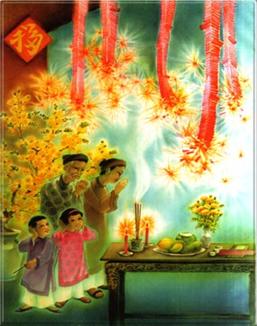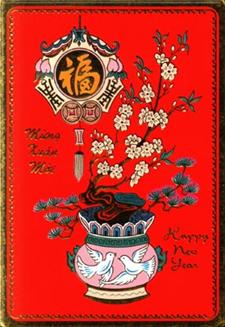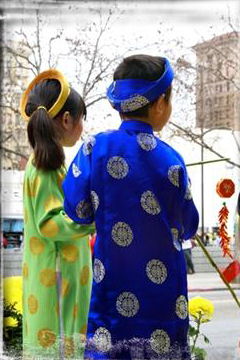 |  |
| Phần 1 | Phần 2 | Phần 3 |
Part 2 – Customs and Traditions
Ancestor’s worship
At the time of this writing, the ancestor’s worship in Southwest region is evolving a lot comparing to pre-1975.A very popular custom among Vietnamese is the cult of the ancestors. In every household, an ancestor altar is installed in the most solemn location. Southwesterners believe that their ancestors still have a great influence on the fate of their living today. The dead and living persons still have spiritual communion; in everyday life, people must not forget that “they enjoy and how they feel” is the same as it is for their deceased relatives. [16]
On the anniversary date of an ancestor’s death, descendants and relatives gather and prepare a ceremony to worship the dead, to bid farewell to deceased persons and to ask for health and happiness for themselves. From generation to generation, ancestor’s worship customs have always been preserved. There are some variations in those customs among the many Vietnamese ethnic groups or religions, but a common theme of fidelity and gratitude towards the ancestors persists.

The way of showing gratitude of the descendants to ancestors is related to the socio-economic conditions. For example, my family had built the tomb of my father which proves current family economic conditions, and my mother is very proud of this because "people think it is the most beautiful and prestigious tomb in Phung Hiep”. This created the jealous sentiment among the family’s members. Thus today we have seen in the cemetery so many large and beautiful tombs. However, the real value of a tomb resides at the care of descendants. The beauty of the tomb does not only prove success in terms of financial conditions but also the dedication of a family with a good moral foundation. Along with worship, the grave of our father highlights the moral strength of our family.
Each year on the anniversary date of ancestor’s death, the Southern people organized ceremony to bid farewell to our deceased parents and grand parents. According to the traditions, we offered to the deceased his favourite dish with a bowl of rice, on the altar, the same plate he liked, as if he was still alive. Therefore the Southwesterners called the anniversary ceremony with a new name as "worship of rice”. The guests as well as family members gather together to share good souvenirs of the death. Master of ceremony which is often head of family, well dressed in fresh cloth and carefully examines all offerings before stepping on floor covering in front of the altar, knelt, hands crossing the forehead and bowed four times. One of two accompanies who usually are children or descendants, standing on the two-sided of altar gave the family chief 3 incense sticks and backed off to their usual positions. He then lights three sticks of incense on the altar, kneels, joins hands in front of his chest, bows his head and prays. Light incense was lit before, when the food is presented on. The second accompany opens liquor flasks and pours wine in three cups, one of water and others with wine.
After the ceremony, the entire family sits down to enjoy the meal typically consisting of steamed chicken, bamboo shoot soup, banh tet and fresh fruits. They reminisce with their ancestors.
In general the Southwesterners are really proud of worshipping ancestors, or in other words this gives them the opportunity to communicate and develop closer relationships among relatives and to share old sad, happy souvenirs together.
I remember one instant on the eve of my father’s funeral reception, all relatives from my father’s and mother’s sides gathered together, some from Phong Dinh and others mostly from SócTrăng and Bạc Liêu, the serving of a warm meal had created the sentiment of family ties among the siblings.
It is said that the ancestor ceremonies have played a very significant role in the life of Southwestern people in particular and of Vietnamese in general today.
Grave Visiting Ceremony “Têt Thanh Minh”
Visiting the ancestral tomb is a special aspect of Southwestern culture, considered as a religion of "cult of our ancestors" which has become a long tradition. Despite difficult living conditions, even though three to four years working far away, but Southwestern inhabitants won’t forget to be home for a family reunion. Many families believe that “tet Thanh Minh” is a good occasion to express gratitude to their grandparents, tell the stories happened to the members of their families.Early in third month of lunar year (usually late March or early April), the weather is called “Thanh Minh”. Thanh Minh means cool sky, clear and fresh. It is time for people to visit their ancestor’s grave, they then remove weeds, clean trees around the tomb, or renovate the tomb of the deceased family ancestors of several generations. They believe that the tomb of their ancestors is the house of the deceased person. Therefore they decorate the graves and maintain the tomb as clean as a magnificent and beautiful place of living.
Chinese Lunar New Year
According to occidental tradition, Christmas is the most solemn day of the year while Asian people celebrate the most popular Chinese Lunar New Year instead, where as the formal name is Nguyên-đán. New Year’s like Christmas, New Year’s and Valentine’s Day in the West, all wrapped into one angst-ridden celebration. Tết is a very important festival because it provides one of the few breaks in the agricultural year, as it falls between the harvesting of the crops and the sowing of the new crops. [16]
Southwesterners do not say “celebrate” when speaking of Tết, the word “to eat” is used as expression. They said “go home to eat Tết” which became an unforgettable tradition. The childhood nostalgia reminded me of the New Year flower market set along the river in my town. Hồ Nước Ngọt recreational center of Sóc Trăng offered a variety of entertaining games and plays for children.
In my childhood Tết was often the most exciting part of our life. The best outfit was always worn on the first day of the year. I can hardly wait for the first day of New Year to wear brand new cloth and shoes to visit our relatives in Phong Dinh. We came home then with a lot of red envelopes “lì xì”. My family prepared well in advance for the New Year by cleaning the house, polishing the copper and silverware and paying off all their debts, if possible.
Tết is also a season’s greeting among friends and relatives. They offered red envelopes which symbolized luck and wealth. This is a cultural practice of Southwesterners that has been maintained for generations. It is very common to see older people giving away sealed red envelopes to younger people with money in it. Before the younger ones could receive the envelopes, they have to perform a certain verbal greeting.
Flower buds and blossoms are the symbols for new beginnings. These two distinctive flowers are widely sold and purchased during Tết. Hoa Mai is the yellow apricot flowers often seen in Southern Viet Nam. Hoa Mai is more adaptable to the hot weather of Southern regions, thus, it is known as the must- have flower in every home. Hoa Anh Đào are the warm pink of the cherry blossoms that match well with the dry, cold weather from the North. Tết is not Tết if there were no sight of Hoa Mai (South) or Hoa Anh Đào (north) in every home.
I remember my mother provisionned all materials and ingredients a few weeks in advance to make “bánh tét” (sticky rice cake), incense, various fruits. The Tet ambience might be felt everywhere a month prior to Tet in Southern region. For young girl and boys Tet is the great occasion to know and get acquainted with each others as new lovers…
Giao Thừa is the most sacred time of the year. In the old days, Tết was celebrated with fireworks and firecrackers. We believed that the loud noise would scare the evil spirit away and bring good fortune. Massive strings of fireworks, the longer the better, are attached to the front of every house. When New Year's Eve comes, everyone competes in burning fire crackers.
The Tết’s ceremony is held on the first day of the New Year before noontime. The head of the household should perform the proper ritual (offering food, wine, cakes, fruits, and burn incense) to invite the souls of the ancestors to join the celebration with the family. This is the time families honour the souls of their ancestors and present the welfare of the family.
The days after the New Year are the time for visiting extended family and closed friends and no one dares to arrive empty handed. People visit the most loved ones on the first day, and the less important ones on the second and third days. The custom of “xông đất” or “xông nhà” still remains nowadays, especially among families with businesses. Therefore, the first houseguest to offer the greeting is very important. If that particular guest has a good aura (well respected, well educated, successful, famous, etc.), then the family believes that it will reflect the family’s future luck, good fortune and wealth throughout the year. It is a common belief that during the first three days of Tet, it is not allowed to clean the house because they believe that such gesture will get rid of the good fortunes and chances.
Despite all changes, that rapid development has wrought today, the family is still the most important institution in the Southwestern society.
Mid-Autumn Festival (Festival of the Moon)
The Mid-Autumn Festival is a children's celebration in which the adults also join. Festival of the Moon, Moon cakes. Moon cakes or "mid-autumn cakes" are a mixture of fruit and other sweets wrapped up in a thin crust in the shape of a full moon, about two or three inches in diameter and a half-inch thick. According to a long established custom moon cakes must be exchanged with relatives and friends on the day preceding the Autumn festival. [16]Starting from the beginning of the eighth month in lunar calendar, the markets in the Southwest are filling of nuances of Mid-Autumn Festival. Lanterns, moon cakes, white coconut cakes are sold everywhere in the splendidly lighted shops. The streets are full of people buying and those who wander at leisure all crowding and pushing one another during these festival-like days.
Besides the assorted paper lanterns, cakes, candies, there are toy animals made of rice dough, the dragon (unicorn) heads and faces of the Earth God made of paper and displayed everywhere in the markets. In rich families, the mid-autumn banquet is organized in order to show up their nubile girls' cooking abilities. This is a truly animated sight. This is a delightful festival for children and most pleasant for the adults to watch.
In many Western countries where the Vietnamese children are living, there is a special festival day for children called Halloween. On this day, the children dress themselves up as sorcerers, supermen, monsters; they swarm in many bands, and scare people while asking for candies. What a fun sight!
However, Halloween seems very similar to the Vu-Lan day in Vietnam. According to ancient’s superstition, on the Vu Lan day, the spirits are released from Hell to the Land of the Living in order to have a good time. So, every family prepares to feast offering to the spirits. The offerings are then distributed to children and the poor people.
The welcome-the-moon party in the evening is a good opportunity for the children not only to enjoy the food, but also to learn more from their grandparents and parents. They are told how to prepare the party in the most attractive way. To decorate the party, there is always a "doctor" made of paper or dough, which reminds the children of the high achievements to be obtained in their studies. The time to start enjoying the party is solemnly shared by the whole family and becomes the most sacred moment of the Mid-Autumn Festival. In the bright moonlight, clear sky and fresh environment, everybody is relaxed with a pure and detached joy.
Wedding of Southwesterners
In the old days of Southwestern region, marriage was inconsistent with current civilization. The couple got married at very young ages, let say 14 to 15 years old. Therefore our grandfather’s families got often a lot of children and they thought that was the happiness to have plenty of children. The intellectual development was not mature and they were already married. Many girls whose mouth still tainted with milk was made wife to other family. So the baby was born immature and difficult to raise or with weak body or disability which resulted in a weak race. Moreover, the young kids are at the age to get a good education, to learn life lessons in order to build a strong and better family later. Then they got married so young and they would rely on the future of their children only, lack of intellectual matter.Nowadays boys and girls tend to get married at an older age. Marriage was and continues to be an important event in the life of Southwesterners. The procedure of ancient wedding ceremony was very complicated and considered as less civilized. First, there was a proposal ceremony (dam hoi equivalent to occidental engagement) in which the groom’s family brought offerings to the bride’s house, after which the young couple was considered to be engaged. Then, there was a ceremony during which the groom’s family brought flowers and fruits to the brides’ parents.
The main celebration would take place on a previously selected date and time when the groom’s family would go to the bride’s house to take her away. The day after the wedding, the couple went to the bride’s house to worship her ancestors.
Ancient wedding ceremonies were very expensive, and today they tend to be much simpler.
Engagement is an important ceremony before the wedding which involves both fiancé’s and fiancée’s families. In the past, engagement ceremony was considered as important as the wedding ceremony because it was an official day to announce the wedding, the relationship between two families. Nowadays, it is less important and varied for each region. In the big city the engagement ceremony could be celebrated 1 day before (and 1 month in the countryside) the wedding ceremony.

In the past, a groom of 20 with an 18-year-old bride would be considered an ideal couple. Today, education, female emancipation, and the need to pursue a career have raised the figures by five or even ten years for middle-class city dwellers. Working class couples in the countryside still tend to marry earlier.
The first step of marriage is usually when the young man's parents consult a fortune-teller to see whether the couple is destined to live together as husband and wife. If so, he will formally request the young woman's hand. The young woman's parents will usually ask for a sum of money to cover the costs of the marriage preparations.
South Vietnamese people believe that some days are particularly auspicious, so choosing appropriate days for the engagement and the wedding is another task for the fortune-teller.
The wedding ceremony starts in front of the altar. The bride and the groom would kneel down and pray, asking their ancestors' permission to be married, also asking for blessing on their family-to-be. The couple then turn around and bow to the bride's parents to thank them for raising and protecting her since birth. They then bow to each other, to show their gratitude and respect toward their soon-to-be husband or wife. The Master of the Ceremony would gave the wedding couple advices on starting a new family. The groom and the bride's parents would take turn to share their experience and give blessing. The groom and the bride then exchange their wedding rings. The parents will give the newly wedded value gifts such as golden bracelets, ear rings, necklace... The ceremony is ended with a round of applause.
Today, a lot of Vietnamese couples have their wedding ceremony done in Temples or Churches which is very much similar to American and Western style, renting Mercedes-Benz to bring the bride to the groom’s home including exchanging vows and wedding rings. However, they still maintain Vietnamese traditional ceremony at the bride's home before heading to temples or churches.
Nguyễn Hồng Phúc - Canada
(Taberd 12B2 – 72-73)
| Phần 1 | Phần 2 | Phần 3 |
Cập nhật 12-10-2012
